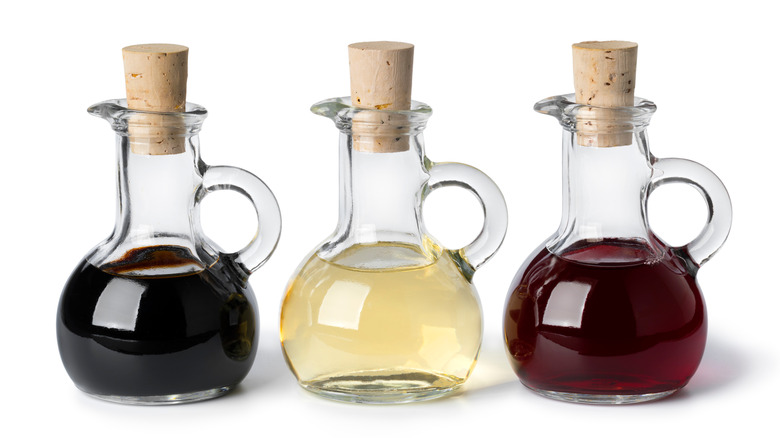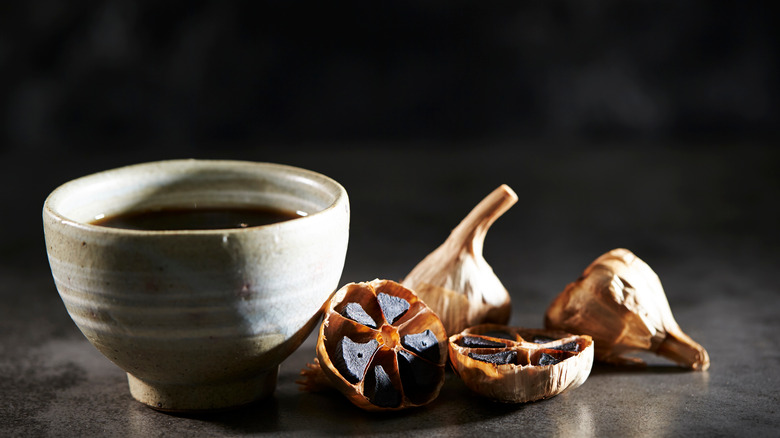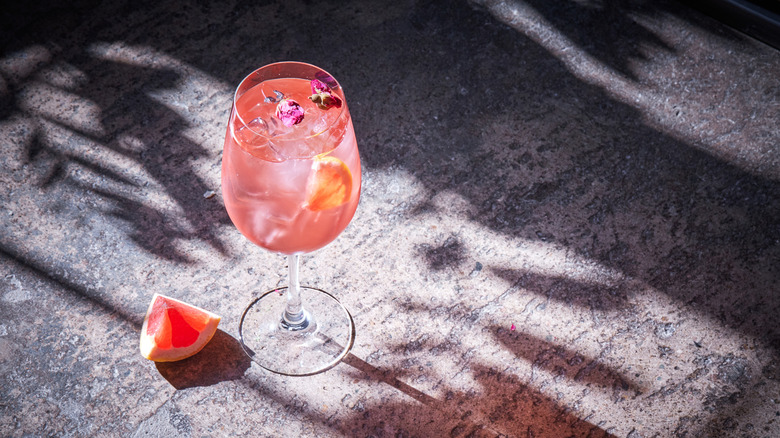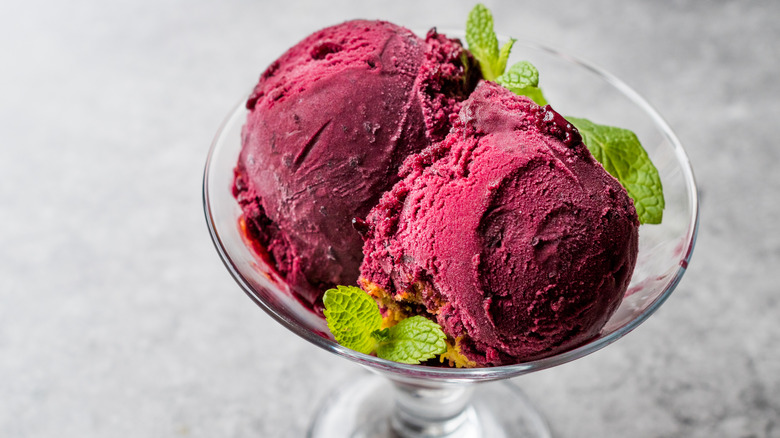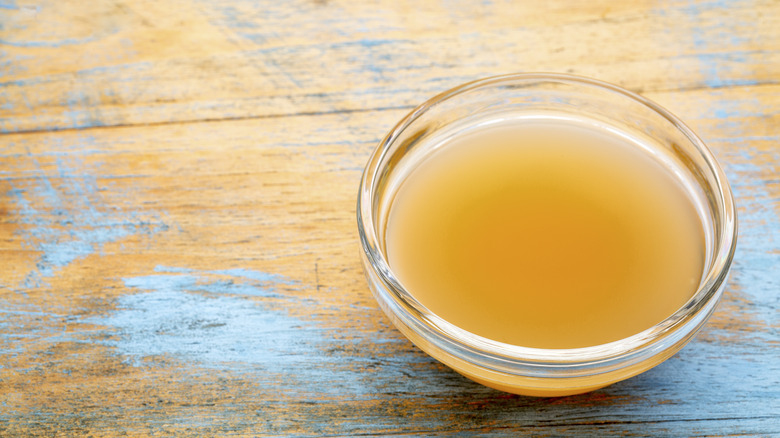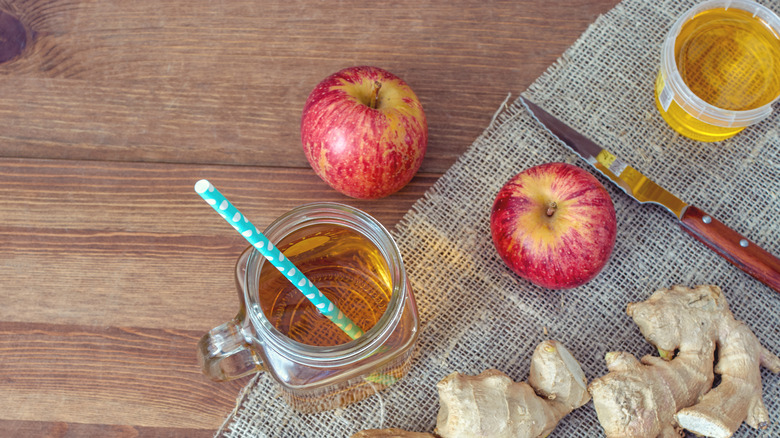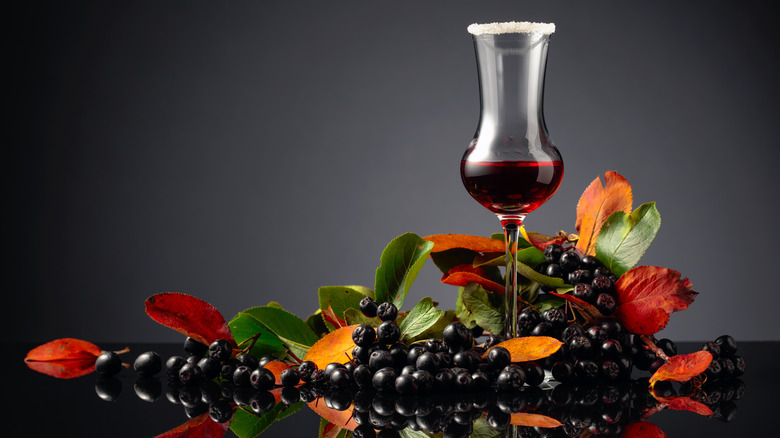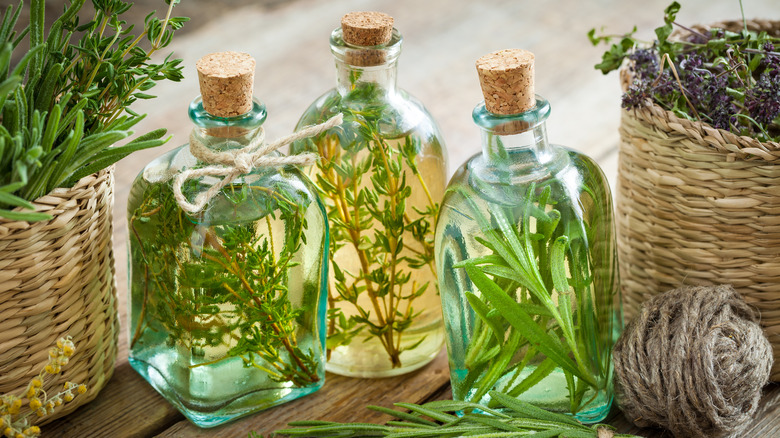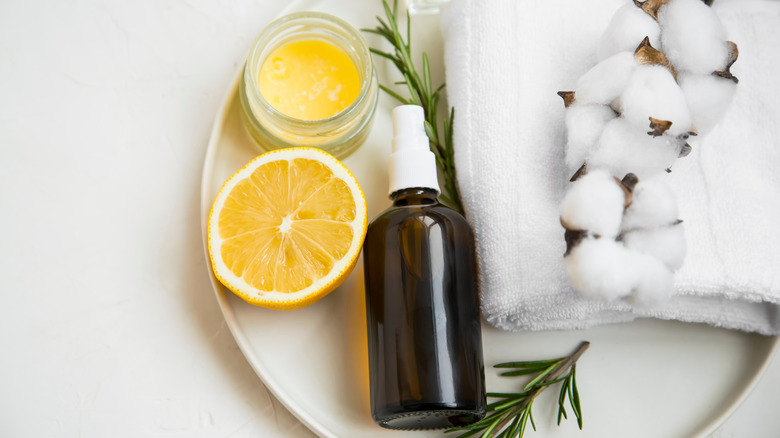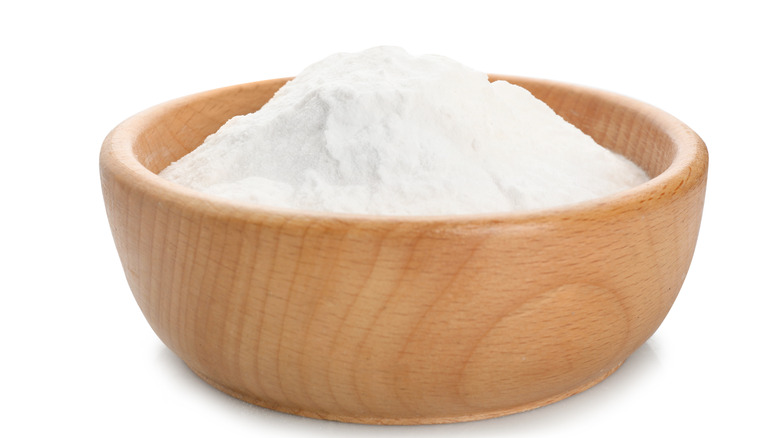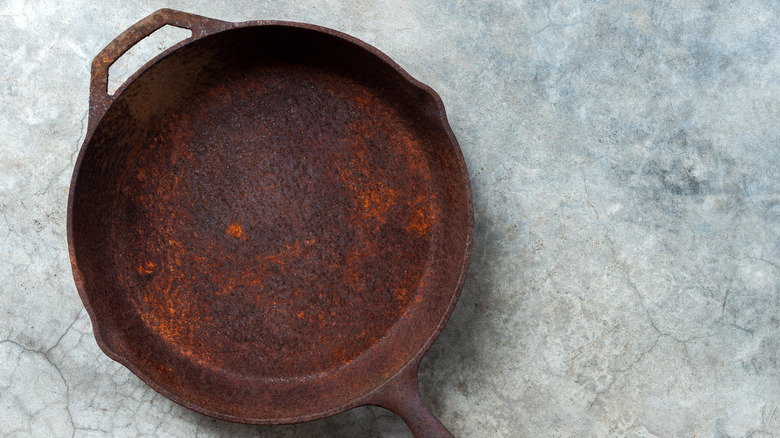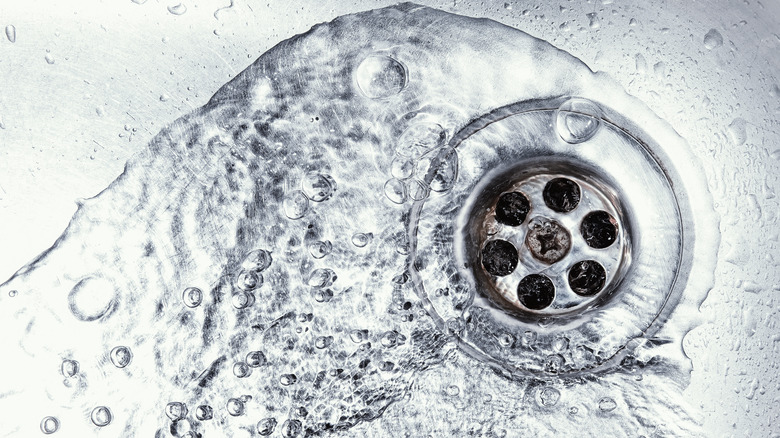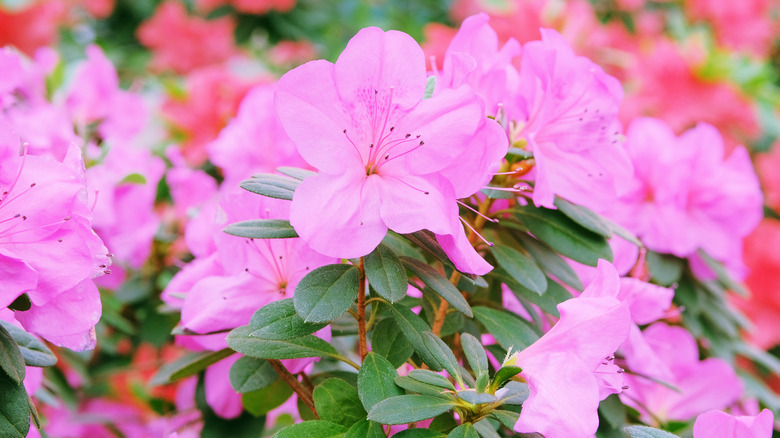16 Uses For Vinegar You May Not Know About
For most of us, the word vinegar calls to mind "and oil," either as a salad dressing or as things that don't mix. There may be a few half-used bottles in the pantry: wine for salad dressings, white for cleaning, and malt ... because your ex loved fish and chips.
Vinegar comes in colors from white to black to Fujian Yongchun's rich red (via Supreme Vinegar), and from bright champagne vinegar to aged, often expensive, and sometimes counterfeit balsamic. In the kitchen alone, says Fine Cooking, vinegar can keep pasta from sticking, thicken sauces, "cook" fish for ceviche, and turn milk into cottage cheese. There isn't a genie in that bottle, but there's enough science to look like magic.
Vinegar is like a superhero passing as your neighbor, good for a "Hi" when taking out the recycling or walking the dog. Want to whip up a satisfactory salad dressing? Grab that half-bottle from the cupboard, add mustard and olive oil, and you're set. But, between walking Fido and taking out the rubbish, your neighbor's actually saving the planet. While vinegar can't rescue a bus full of screaming schoolchildren from a broken bridge, it can sub for some toxic chemicals in your house, boost your health, clean your hair, season dishes from soups to desserts, and serve you a cocktail or sports drink along the way.
Clear the pantry. Once you know all vinegar is good for, you'll want to give it space.
1. Tart up your soups
There's something spectacularly comforting about sinking a spoon into a bowl of soup. Save the wine for toasting what you're celebrating, and use vinegar to tart up your soup. José Andrés' can cool your summer with a luscious gazpacho refined with good sherry vinegar (via Washington Post). Coming in from the cold? Steam-heat winter with take-out style hot-and-sour soup, which gets a delectable tang from black vinegar.
If you can't find black vinegar, don't despair. A blend of red wine and balsamic vinegar can work as a substitute. Red wine vinegar's a common component of black bean soup. Make it vegan by swapping out the Greek yogurt for a non-dairy version. Feeling fancy? Wrap your soup. The Woks of Life make it easy to make soup dumplings. The black vinegar sauce is a flawless foil for the fatty mouthfeel of the filling's pork and broth. As it turns out, spooning vinegar into your mouth isn't a nightmare; it's a dream.
2. Like a silky black dress or a hand-tailored tux, black vinegar brings a rich elegance to every season
In Eastern Asia, this grain-based vinegar is an open secret and a dark staple in countless dishes. As Bon Appétit's tart tour reveals, from region to region and nation to nation, flavors and production methods vary, although everyone gives the brew time to rest. Grape-based balsamic vinegar ages in barrels; whereas black vinegar is aged in clay pots for a minimum of six months to a number of years. The longer it rests, the more nuanced its flavors grow, and the more depth its taste and color acquire.
Black vinegar's birthplace was China, where it may be made with wheat bran, barley, sorghum, or sticky rice, depending on the province that's producing it. Courtesy of a fungus, Fujian's glutinous rice vinegar veers more red than black. Taiwanese black vinegar starts with sticky rice; much of its flavor comes from infusions. In Japan and Korea, brown rice is the base. Think of black vinegar the way you do spices; each will complement its version of local food.
Break your take-out habit, and try your hand at making scallion pancakes and a dish of black vinegar sauce for dipping, or break in your new wok with a stir-fry that calls for a dash of black vinegar. Don't be afraid to experiment. Black vinegar is adaptable.
3. Vinegar's unfermented cousin, verjus goes great in mocktails
When we hear the phrase "sour grapes," we tend to think about grumbling. Fortunately, folks in the Middle Ages and the Renaissance took a more pragmatic approach to the unripe fruit of the vine. They pressed it and used the sour juice in the kitchen.
You can use it in salad dressings, sauces, drinks, desserts, and vinaigrettes. If you have an open bottle of verjus, and aren't likely to finish it within a couple of months, then pour it into ice-cube trays — perfect portions for salads or cocktails.
Bake like a Great British chef. Pick up a package of puff pastry, and make a caramel mille-feuille with mango and crystallized chili peppers. That little hit of verjus in the mangoes rounds out the sweetness and brings out the freshness of the fruit. Spare yourself the run to the store for lemons or limes. Liquor.com unveils ways verjus shines in cocktails. Keep it uncomplicated and alcohol-free with an Imperial, or use it in a classic French 75. A simple swap can bring a wealth of refreshing ease.
4. Make vinegar part of a delicious dessert
Verjus does a dessert good. So does vinegar. Nourish your inner pastry chef, and let vinegar sweeten your culinary imagination. Like a sharp-tongued sibling, vinegar earns the right to play with every course, from start to end. Limit it to savory dishes, and you deprive yourself of geeky (Vinegar's kitchen magic is not just for classrooms.) sweet-and-sour contentment.
Vinegar can be incorporated into a range of comforting sweets. Baking soda and white vinegar ensure that this classic wacky cake is as fluffy as it is chocolaty. It's a one-bowl blend, so clean-up is easy, too: a bonus for the baker. With its balance of tartness and sweetness, vinegar pie is a rightful classic. You can use white or cider vinegar, making it perfect for using the last of a bottle. With their crisp snap and melt-in-the-mouth texture, vinegar cookies make a buttery gift for any occasion ... but vinegar sweets aren't only for homespun goodness.
Add elegance to dinner, ending with a strawberry balsamic sorbet or Master Chef's Vinegar Sorbet, Rhubarb Compote, and Almond Granita. If you've had a hard day, turn one of these frosty glories into a solitary indulgence by bringing a cold bowl to your hot bath. It's almost like owning a spa ... almost.
5. Let your vinegar make more vinegar
Is a fog lurking at the bottom of your bottle of raw cider vinegar? A blob bobbing in your red wine vinegar? Don't panic. Say, "Hello, mother."
That thick funk at the bottom of the bottle or tentacle-free jellyfish swimming in the liquid isn't an invader; it's the vinegar mother. You can nurture the mother from raw vinegar or follow Nancy Leson's "purchase a mother" route, as laid out in the Seattle Times. If you have a kombucha-fermenting friend, then this may be familiar to you.
Whether you buy it or nurse it, this blob's a gift. It'll take that uncapped half-bottle of overexposed wine to transform it into homemade vinegar. Bon Appétit makes it look easy — and it is. All the alchemy requires is a jar, a clean towel, a dark space, and patience. Depending on the temperature and climate, the transformation may take weeks or months.
Give it the occasional stir and taste. When it's as acidic as its parent bottle, it's done. Pour it into a bottle, as full as you can get it, cap it, and use it or let it age. As to the mother, it's ready to make another batch. There's no such thing as too much homemade vinegar; put a label on the bottle — maybe with the name and vintage of the original wine — add a ribbon, and give it to a food-loving friend.
6. Homemade switchel can quench your thirst
Switchel's a traveler with a history so murky even the Smithsonian admits it's cloudy. It may have come from the Caribbean and followed the British across the Atlantic. It may be a creation of the Amish, who use it to this day. There's plenty in this restorative drink to appeal to thrifty farmers: it hydrates farmhands, enables them to keep doing hard physical labor and, being based in vinegar and whatever sweetener's at hand, reduces waste and puts leftovers to good use.
Where switchel's concerned, the only constants are water, ginger, and cider vinegar. Switchel can easily be sweetened up naturally by adding molasses, honey, or a little maple syrup. What's good for the farmer is good for the runner, swimmer, and bicycle commuter. Tend yourself like a hard-working farmer.
Feeling sniffly? Take a sidestep from switchel, and add a hint of heat. Think of fire cider as switchel's intense cousin. Based in cider vinegar, fire cider ditches the water, adds seasonings, and throws in some fermentation time for good measure. With citrus, ginger, horseradish, onions, garlic, chiles, and herbs, Martha Stewart's fire cider packs a punch that will clear your sinuses and, some say, cure or stave off a cold. One shot's enough to cure what wants to ail you. Because you made it, you know what's keeping you well.
7. Shrubs aren't just for parks. Some belong in your glass
When bar managers think about shrubs, they aren't considering going to a garden — although they might turn to foraging for herbs to make their shrubs. Chilled is for bartenders, but you're an insider. Go ahead. Look behind the bar, where shrubs are syrups made with vinegar, fruit, seasonings, and sugar. Like jams, they're wonderful for preserving the seasons. They can be blended with seltzer to make a natural soda, poured over sorbet to add a complementary or contrasting flavor, or turned into remarkable seasonal drinks.
When you make shrubs, you're building on very old traditions. Drinking vinegar dates back to the Roman Empire. Build safely. Use a vinegar that has a minimum of 5% acidity, keep your space and your equipment clean, and you're good to garden — erm, shrub. Your recipe can be fancy or as simple as the New York TIme's suggestion of adding a little cherry and mint flavoring. It can use heat or stay cool all the way (Liquor.com shows both methods: In freedom, there is taste.), keeping fruits' flavors fresh and clear. You can shop for a purpose, or be inspired by what's at the local farm stand or green market. With centuries of drinking vinegar behind us, there's plenty of room to experiment and play.
8. Stir up a vinegar cocktail
At Tales of the Cocktail, the world's best bartenders gather to teach, learn, and share tricks of their hospitable trade. While the thought of vinegar in drinks could be too tart for your cocktail dreams, the fact that bartenders at Tales attended a seminar on that acetic subject might make you think again — and if Difford's Guide is talking about it, it's a fact you want to drink. Play like the pros. Pillage the pantry for cider, sherry, or balsamic vinegar, and up your cocktail game.
Proof's in the glass. Pour the spirit of your choice into Kevin Murphy's adaptable Switchel cocktail, as revealed by LIquor.com; whether you choose light spirits or dark, young or aged, the sage-infused honey (which is gorgeous in tea, too) and cider vinegar will produce a beautifully balanced drink. Geoffrey Zakarian's balsamic vinegar and agave nectar reduction gives his luxurious Balsamic Boulevardier extra depth and richness. When friends praise you, silently thank Food Network for putting the best on the bar.
Spend 10 minutes in the kitchen, and earn awestruck appreciation from the pickiest cocktail-lovers in your life. No, you don't need to share your secret. What's stirred behind the bar stays behind the bar.
9. Vinegar infusions are gifts for the kitchen and the eye
With their chameleon-like ability to incorporate flavors, vinegars are infinitely adaptable. You can tailor vinegar to suit your needs or fit the foodie desires of spice, fruit, heat, or herb-loving friends. Infused vinegar take on tastes and colors, so you can tint a gift a rosy (raspberry-infused champagne vinegar) bottle, or leave herbs in the liquid for an elegant, fresh-from-the-farm touch.
Given its blush-pink hue and subtle, scallion-like flavor, chive blossom vinegar's popularity is easy to understand. Chive-blossom vinegar's wonderful on a salad, or as a final touch on grilled, chilled carrots. Don't throw away that leftover rosé. Introduce it to lemon verbena, peaches, and unfiltered cider vinegar, and you'll have a peach-rosé vinegar that tastes so good, it's hard to give away. This is a dreamy vinegar, fresh from Food & Wine, perfect for cocktails and alcohol-free drinks. Steep it when peaches are ripe, and it'll make your dry January a delicious ease.
There are infused vinegars for every season: cranberry orange for the winter holidays, hot pepper for autumn grilling, garlic and herb for a summery roasted chicken, lemon tarragon for spring's first greens ... just ask the economical Getty Stewart. Combine vinegar, your imagination, and what's beautiful in the market, add a little time, and you'll have a gift for all dishes, long after the season ends.
10. Make a magical party
This may be the most playful way to repurpose a bottle and enchant your friends. Save your water bottles for a Halloween party. (Don't worry. You can recycle them later.)
Before your haunting event, soak the labels off the bottles. For extra mystery, wrap them in black or orange masking tape, and use a metallic Sharpie to add decorations. No one needs to know what's hiding inside. What's in there? The least expensive vinegar you can buy. What's on top? A balloon, with a spooky face drawn on by you, your children, a ghost-loving relative, or that crafty friend who always arrives early enough to be helpful.
At the party, let two household ingredients transform you into a Halloween wizard. Startle and delight your Halloween guests with Women of Today's self-inflating ghosts. What's the trick? While the vinegar's in the bottle, plain to see, the secret component — baking soda — is hidden in the balloon. Until you encourage your guests to lift their balloons from floppy to upright, nothing will happen. Once you do, though, the baking soda will meet the vinegar, and the balloons will swell, with no human intervention. It's magic!
Why limit yourself to one season? Grace Valentine's Day table with growing hearts (Nothing's as magical as love!), adorn a cupcake party with expanding rainbows, spell the name of the birthday celebrant, or create whatever will bring smiles to your friends, family members, and geeks of all ages.
11. Clear your skin and shine your hair
Vinegar's good for soups and salads. Is it also good for your skin? With citric acid, a natural alpha-hydroxy acid (AHA, on pricey skin products in stores) and polyphenols, it certainly brings benefits. If your skin is sensitive, check with your dermatologist. Vinegar's acidic, and acids can irritate the skin. Always do a patch test, in a discreet spot, and dilute the vinegar in water.
You can share Real Simple's tip: cider vinegar toner is excellent for oily skin. Start with a couple of days a week, to check how your skin reacts. For combination skin, pillage the pantry and make Everyday Health's liquid face mask by blending cider vinegar, honey, and olive oil.
Your face isn't the only part of your body that deserves love and care. Spare some tenderness for your hard-working feet, which bear your weight, tolerate your shoe-shopping expeditions, and tell you how to keep your balance whether you're walking on heels or running across uneven ground. Soak them soft and callus-free with water and Allure's unexpected bathroom-kitchen blend: mouthwash and vinegar. There's science behind it. Vinegar and mouthwash have something in common: acid. For this soft-heeled treat, choose a mouthwash that contains alcohol — not because your feet want a drink, but because the alcohol helps the acids work their wonders. What's the water for? To dilute the blend, keeping it safe for your baby-soft skin.
12. Boost your pet's health
Sometimes, protecting your dog means ditching cleaning products. Chemicals and additives may not be Fido-friendly. While it's tempting to read "natural" or "organic" and think "safe," that isn't necessarily true. According to Cabbagetown Pet Clinic, cats and dogs need to be kept far away from many essential oils, including citrus, pine, eucalyptus, and tea tree oils. If you've been using products with essential oils, don't let fear overwhelm you; just check Wirecutter's guidelines on the safest practices, keep the oils where pets can't touch them, and air out the rooms.
When you're shopping for essential oils — for cleaning or anything else — there's a reliable resource. The ASPCA maintains a list of toxic and non-toxic plants, so you can choose and use products that will keep your home clean, your nose happy, and your cherished animals healthy. Another trustworthy source, the American Kennel Club, has dog-safe recipes to keep your pet happy and your home spotless. While a vinegar-and-water blend won't kill bacteria, it will leave surfaces squeaky clean. Made into a paste with baking soda and hydrogen peroxide, vinegar's also useful in a stain remover — something every pet owner can appreciate.
Modern Dog Magazine extols vinegar's benefits for canine health. Add it to water to help with digestive issues. Dilute it to care for flaky skin or combat yeast infections on your pup's paws. Oh, and vinegar can help get rid of odors left by your beloved dog and cat ... and even the not-so-cherished local skunk.
13. Use vinegar to clean the air in your home
Whether it's staleness from winter-sealed windows, the stench of a toddler's "accident," the reek of the litter pan, or the aromatic memory of a recipe gone wrong, air can acquire odors we'd rather not inhale. Vinegar can clear the air, says Popular Science, without a laboratory-made chemical in its compounds. That's especially welcome news for people with allergies.
Simmer white vinegar, and free its acetic acid on the steam. It will bond with offensive molecules, freeing your nose from olfactory disturbances. To make an aerosol, mix water with white vinegar. Add culinary ingredients, such as lemon, thyme, or lavender — Good Housekeeping likes eucalyptus — to give your mist a refreshing or soothing scent. You can use any spray bottle, but bright glass ones are affordable treats.
You don't have to spray or simmer vinegar to clean the air. Lifehacker suggests setting a bowl of vinegar on a table, where it will erase sniffable errors from the air. An open baking soda box erases the reek from fridges. Apartment Therapy's trick: it does the same in a room. Put both in service — one bowl of vinegar and one of baking soda — and your air will be as pure as laundry on a sunlit line. For extra anti-stench insurance, The Spruce recommends using diluted white vinegar to erase aromas from diaper pails, carpets, and any other stink-holding surface a spray can reach.
14. Clean your kitchen kit
Vinegar's fabulous for cleaning surfaces, but it's also good for smaller jobs. Your coffee-maker is a no-soap zone, but you don't want it developing an old-coffee flavor or becoming a breeding ground for germs. The solution is as easy as it is affordable and a monthly habit of cleaning your coffee maker will yield a better-tasting cup of joe.
Keep your cleaners clean. No lesser authority than Architectural Digest — people who know your home from below-ground up— advocates using vinegar in the dishwasher, so your dishes stay sparkling, instead of clinging to grease and grime. White vinegar can give the refrigerator a deep clean, without putting toxins near your food.
Don't be afraid to take vinegar's acid to your pans. HGTV outlines how to use vinegar to remove that thick crust of burnt-on dinner (No judgment; we all get distracted.), while it also can be used on cast iron skillets to remove a parka-thick coat of rust. This is home economics at its best; vinegar removes the problem and saves you a costly pot-replacement shopping expedition. Take a cool tip from Today: vinegar will clear cooked-on food from the inside of your microwave. According to Apartment Therapy, it will even clean those grease-smeared fingerprints from the buttons. Let the kitchen shine!
15. Use vinegar to unclog those pipes
Toilet clogged again? The ultimate authorities on sorting no-flow drains, plumbers advocate giving baking soda and vinegar a chance to clear that up. With a name like Mr. Rooter, this firm has to know how to root out a clog — and if a business is willing to share a do-it-yourself cure, putting the company's reputation on the line, then you can bet it'll clean the pipes.
Don't start this pipe-clearing endeavor expecting immediate transformations. The vinegar and baking soda pipe-cleaner is far from an instant fix. After you've added the vinegar to the baking soda, you have a good 20-minute wait. Use it as an excuse. The delay gives you time to catch up on business emails or have a mini-binge of your favorite series. Be sure to tell everyone else in the house to share the wait. One early flush means a reset, and starting the process and the timer again.
You can also use vinegar and baking soda to clean your kitchen sinks and drains. That's what CNET says, and they do their research. Here's a bonus: vinegar and baking soda are far easier on the pipes and the planet than chemical drain cleaners. You're saving your bank account, your home, and the Earth at the same time. Hmm, maybe you've earned more than a mini-binge.
16. A vinegar garden is a happy garden
The List says vinegar and sugar keep cut flowers looking fresh. Beyond the vase, vinegar is a powerhouse in the garden. An ounce of acetic prevention can save more than a pound of cures. What's a whisper of scent to you is a shout of stench to many garden invaders. How much watercress can a woodchuck eat? Take vinegar to the garden, and you may never need to know. As House Digest suggests, a few sprays of vinegar in the garden keep pests such as toads and frogs at bay. Set them out of your sight, and smack in sniffing distance for curious rabbits and other vegetable thieves. Vinegar, peppermint, and rosemary make an effective deer repellent.
Remember the "Game of Thrones" Red Wedding, when Walder Frey took relentless revenge against Robb Stark and his company? If snails are chewing through your herbs, set out a broken pot or piece of wood as shelter, and tuck in citrus rinds for them to eat. When the morning sun brightens the day, you'll find snails hiding and feasting. Grab a spray bottle of vinegar, as Hunker suggests, and put unwelcome guests to an early end. In this scenario, you are not the hero — but it may be hard to persuade your heirloom tomatoes, perilla leaves, and Alpine strawberries of that.
Add one cup of vinegar to a gallon of tap water, give the soil an acidic boost, and free iron for azaleas, gardenias, and rhododendrons to turn into healthy roots and brilliant petals.
